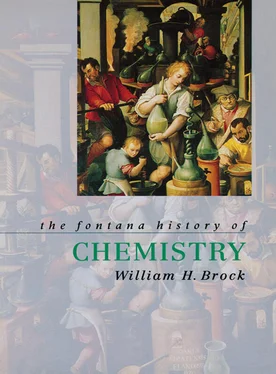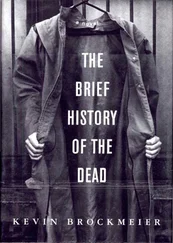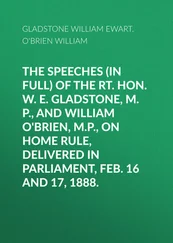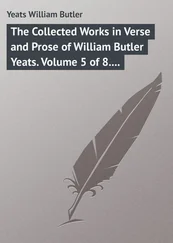One final Encyclopédie article seems to have influenced Lavoisier decisively at this juncture. This was an essay on ‘expansibility’ published in the sixth volume in 1756 by another pupil of Rouelle’s, the philosopher and civil servant, Jacques Turgot. Like Lavoisier, Turgot combined a career of public service with spare-time research in chemistry. But he never published his reflections (or if he did so, he did it anonymously), and we only know of his interesting thoughts from his private correspondence. Turgot arrived independently at the same solution as Lavoisier, namely that Guyton’s experiments could be explained as due to the fixing of air. He had actually learned of Guyton’s work before Lavoisier in August 1771. In a private letter to Condorcet, Turgot noted 3 :
The air, a ponderable substance which constantly enters into the state of a vapour or expansive fluid according to the degree of heat contained, but which is also capable of uniting with all the other principles of bodies and forming in that state part of the constitution of different compounds … this air combines or separates in different chemical reactions because of a greater or lesser affinity that it has for the principles to which it was attached or with those that one presents to it.
Given that Lavoisier was party to the same intellectual influences as Turgot, it was not surprising that they should have reached the same conclusions. Whether Lavoisier was aware or not of Turgot’s thoughts, he took pains constantly to preserve priority of the idea that it was air that was fixed in calcination, rather than liberated, as he had first thought earlier in 1772. If air was an expanded fluid combined with phlogiston, as Turgot’s Encyclopédie article had suggested, then the phlogiston released during combustion (the process of ‘fixing air’) would explain the heat and light generated during the reaction. It followed that heat and light came from the air, not the metal as the Stahlians had always maintained:

Lavoisier was able to verify this in October 1772 by using a large burning lens belonging to the Academy. When litharge (an oxide of lead) was roasted with charcoal, an enormous volume of ‘air’ was, indeed, liberated. In order to investigate this phenomenon more closely, and in order to ensure priority after finding that sulphur and phosphorus also gained in weight when burned in air, Lavoisier deposited a sealed account of his findings in the archives of the Academy, which he allowed to be opened in May 1773 4 :
What is observed in the combustion of sulphur and phosphorus, may take place also with all bodies which acquire weight by combustion and calcination, and I am persuaded that the augmentation of the metallic calces is owing to the same cause. Experiment has completely confirmed my conjectures: I have carried out a reduction of litharge in a closed vessel, with the apparatus of Hales, and I have observed that there is disengaged at the moment of passage from the calx to the metal, a considerable quantity of air, and that this air forms a volume a thousand times as great as the quantity of litharge employed. This discovery seems to me one of the most interesting that has been made since Stahl and as it is difficult in conversation with friends not to drop a hint of something that would set them on the right track, I thought I ought to make the present deposition into the hand of the Secretary of the Academy until I make my experiments public.
In committing himself to the hypothesis that ordinary air was responsible for combustion and for the increased weight of burning bodies, Lavoisier demonstrated that he was ignorant of most contemporary chemical work on the many different kinds of airs that can be produced in chemical reactions. In Scotland, a decade earlier in 1756, Joseph Black had succeeded in demonstrating that what we call ‘carbonates’ (e.g. magnesium carbonate) contained a fixed air (carbon dioxide) that was fundamentally different in its properties from ordinary atmospheric air. Unlike ordinary air, for example, it turned lime water milky and it would not support combustion. Black’s work did not achieve much publicity or publication in France until March 1773. A few years later, Henry Cavendish studied the properties of a light inflammable air (hydrogen), which he prepared by adding dilute sulphuric acid to iron. These experiments were to stimulate the astonishing industry of Priestley who, between 1770 and 1800, prepared and differentiated some twenty new ‘airs’. These included (in our terminology) the oxides of sulphur and nitrogen, carbon monoxide, hydrogen chloride and oxygen. The fact that most of these were ‘acid’ airs was to be, for Lavoisier, an intriguing phenomenon.
Hence, although largely unknown to Lavoisier in 1772, there was already considerable evidence that atmospheric air was a complex body and that it would be by no means sufficient to claim that air alone was responsible for combustion. Lavoisier seems to have been aware of his chemical ignorance. He wrote in his laboratory notebook on 20 February 1773:
I have felt bound to look upon all that has been done before me as merely suggestive. I have proposed to repeat it all with new safeguards, in order to link our knowledge of the air that goes into combination or is liberated from substances, with other acquired knowledge, and to form a theory.
And, with the firm and confident intention of bringing about, in his own prescient words, ‘a revolution of physics and chemistry’, he spent the whole of 1773 studying the history of chemistry – reading everything that chemists had ever said about air or airs since the seventeenth century and repeating their experiments ‘with new safeguards’. His results were summarized in Opuscules physiques et chimiques published in January 1774.
Ironically, far from clarifying his ideas, his new-found familiarity with the work of pneumatic chemists now led him to suppose that carbon dioxide, ‘fixed air’, in the atmosphere was responsible for the burning of metals and the increase of their weight. This was not unreasonable, and the explanation for Lavoisier’s misconception will be clear. Most calces (that is, oxides) can only be reduced to the metal by burning them with the reducing agent, charcoal (C), when the gas carbon dioxide is produced:
calx + C → metal + fixed air
It was easy to suppose, therefore, that the same fixed air was responsible for combustion:
metal + fixed air → calx
As he noted plaintively in a notebook 5 :
I have sometimes created an objection against my own system of metallic reduction which consists of the following: lime [CaO] according to me is a calcareous earth deprived of air; the metallic calces, on the contrary, are metals saturated with air. However, both produce a similar effect on alkalies, they render them caustic.
Obviously, Lavoisier needed to distinguish between air and fixed air, carbon dioxide. It should be noted how this reasoning was based upon the complementarity of analysis and synthesis. If two simple substances could be combined together to form a compound, then, in principle, it ought to be possible to decompose the compound back into the same components. Lavoisier was to find a perfect example of this in the red calx of mercury, a substance that caused him to revise his original hypothesis significantly.
Two things caused Lavoisier to change his mind. First, his attention was drawn by Pierre Bayen, a Parisian pharmacist, to the fact that, when heated, the calx of mercury (HgO), a remedy used in the treatment of venereal disease, decomposed directly into the metal mercury without the addition of charcoal. No fixed air was evolved. As Bayen pointed out, this observation made it difficult to see how the phlogiston theory could be right. Here was a calx regenerating the metal without the aid of phlogiston in the form of charcoal! Secondly, the mercury calx had also come to the attention of Priestley because of a contemporary uncertainty whether the red calx produced by heating nitrated mercury was the same as that produced when mercury was heated in air. In August 1774 he heated the calx in an enclosed vessel and collected a new ‘dephlogisticated air’, which he found, after some months of confusing it with nitrous oxide, supported combustion far better than ordinary air did. Unknown to Priestley the Swedish apothecary, Scheele, had already isolated what he called ‘fire air’ from a variety of oxides and carbonates in the years 1771–2. But Scheele, working in isolation even in Sweden, did not help to shape Lavoisier’s views in the same way that Bayen and Priestley did. These experiments were reported directly to Lavoisier by Priestley when he was on a visit to Paris during October 1774, but he also published an account of the new air at the end of the same year.
Читать дальше













